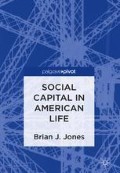Abstract
What do we know? What don’t we know? Significant questions remain about social capital, including: have Americans’ core social networks shrunk? What is the nature of the trend in voluntary association? What is the sociological substance of the post-9/11 surge in social activity? And, ultimately: what are the interconnections of social capital and psychological attitudes?
Access this chapter
Tax calculation will be finalised at checkout
Purchases are for personal use only
Notes
- 1.
Federal Bureau of Investigation, Crime in the United States (U.S. Govt. Printing Office, 2014).
- 2.
Steven Peter Vallas, Work (Polity Press, 212), 1.
- 3.
Juliet B. Schor, The Overworked American: The Unexpected Decline of Leisure (Basic Books, 1992), 28–29, 1–2.
- 4.
Youngjoo Cha and Kim A. Weeden, “Overwork and the Slow Convergence in the Gender Gap in Wages,” American Sociological Review (June 2014, 79), 457–485.
- 5.
Stephanie Coontz, Marriage, a History, op. cit., 11.
- 6.
Deborah Chambers, A Sociology of Family Life (Polity, 2012), 176.
- 7.
Jacqueline Olds, M.D., and Richard S. Schwartz, M.D., The Lonely American: Drifting Apart in the Twenty-First Century (Beacon Press, 2009), 1.
- 8.
Miller McPherson, Lynn Smith-Lovin, and Matthew E. Brashears, “Social Isolation in America: Changes in Core Discussion Networks Over Two Decades,” American Sociological Review (June 2006), 353–375.
- 9.
Claude S. Fischer, “The 2004 GSS finding of shrunken social networks: An artifact?,” American Sociological Review (2009, 74), 413–428.
- 10.
Matthew E. Brashears, “Small Networks and High Isolation? A Reexamination of American Discussion Networks,” Social Networks (2011, 33), 331–341.
- 11.
Hua Wang and Barry Wellman, “Social Connectivity in America: Changes in Adult Friendship Network Size from 2002 to 2007,” American Behavioral Scientist (2010, 53), 1148–1169. Using data from Center for the Digital Future surveys, they find the average number of (“offline”) friends to have been 9.4 in 2002 and 11.3 in 2007.
Benjamin Cornwell, Edward O. Laumann, and L. Philip Schumm, “The Social Connectedness of Older Adults: A National Profile,” American Sociological Review (April 2008), 185–203. Based on data from the National Social Life, Health, and Aging Project, they estimate average core network size at 3.57. This is about 1.5 network members more than the GSS estimate for 2004 even though it only includes adults ages 57 to 85 who, as the authors point out, are assumed to be less socially active than younger adults.
- 12.
Brashears, Social Networks, op. cit., 32.
- 13.
Fischer, American Sociological Review, op. cit., 418.
- 14.
- 15.
The marriage-age-social capital interaction was introduced in Social Capital in America, op. cit., 81–83.
- 16.
See, for example, Rima Wilkes, “Re-thinking the Decline in Trust: A comparison of Black and White Americans,” Social Science Research (2011, 40), 1596–1610.
- 17.
Useful guides are available in Pamela M. Paxton, John R. Hipp, and Sandra Marquart-Pyatt, Nonrecursive Models: Endogeneity, Reciprocal Relationships and Feedback Loops (Sage, 2011), and Jian Huang, Henriette Maasen van den Brink, Wim Groot, “A Meta-analysis of the Effect of Education on Social Capital,” Economics of Education Review (2009, 28), 454–464.
References
Brashears, Matthew E., “Small Networks and High Isolation? A Reexamination of American Discussion Networks.” Social Networks (2011, 33).
Cha, Youngjoo, and Kim A. Weeden, “Overwork and the Slow Convergence in the Gender Gap in Wages,” American Sociological Review (June 2014, 79).
Chambers, Deborah, A Sociology of Family Life (Cambridge, UK: Polity, 2012).
Coontz, Stephanie, Marriage, A History (New York, NY: Viking, 2005).
Cornwell, Benjamin, Edward O. Laumann, and L. Philip Schumm, “The Social Connectedness of Older Adults: A National Profile,” American Sociological Review (April 2008).
Federal Bureau of Investigation, Crime in the United States (Southampton, PA: U.S. Govt. Printing Office, 2014).
Fischer, Claude S., “The 2004 GSS finding of shrunken social networks: An artifact?,” American Sociological Review (2009, 74).
Huang, Jian, Henriette Maasen van den Brink, and Wim Groot, “A Meta-analysis of the Effect of Education on Social Capital,” Economics of Education Review (2009, 28).
McPherson, Miller, Lynn Smith-Lovin, and Matthew E. Brashears, “Social Isolation in America: Changes in Core Discussion Networks Over Two Decades,” American Sociological Review (June 2006).
Olds, Jacqueline, and Richard S. Schwartz, The Lonely American: Drifting Apart in the Twenty-First Century (Boston, MA: Beacon Press, 2009).
Paxton, Pamela M., John R. Hipp, and Sandra Marquart-Pyatt, Nonrecursive Models: Endogeneity, Reciprocal Relationships and Feedback Loops (Thousand Oaks: Sage, 2011).
Schor, Juliet B., The Overworked American: The Unexpected Decline of Leisure (New York, NY: Basic Books, 1992).
Vallas, Steven Peter, Work (Cambridge, UK: Polity Press, 2012).
Wang, Hua, and Barry Wellman, “Social Connectivity in America: Changes in Adult Friendship Network Size From 2002 to 2007,” American Behavioral Scientist (2010).
Wilkes, Rima, “Re-thinking the Decline in Trust: A comparison of Black and White Americans,” Social Science Research (2011, 40).
Author information
Authors and Affiliations
Rights and permissions
Copyright information
© 2019 The Author(s)
About this chapter
Cite this chapter
Jones, B.J. (2019). Social Capital in American Life. In: Social Capital in American Life. Palgrave Pivot, Cham. https://doi.org/10.1007/978-3-319-91180-9_10
Download citation
DOI: https://doi.org/10.1007/978-3-319-91180-9_10
Published:
Publisher Name: Palgrave Pivot, Cham
Print ISBN: 978-3-319-91179-3
Online ISBN: 978-3-319-91180-9
eBook Packages: Social SciencesSocial Sciences (R0)

